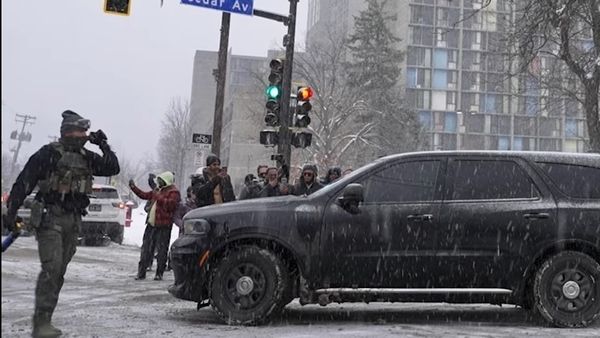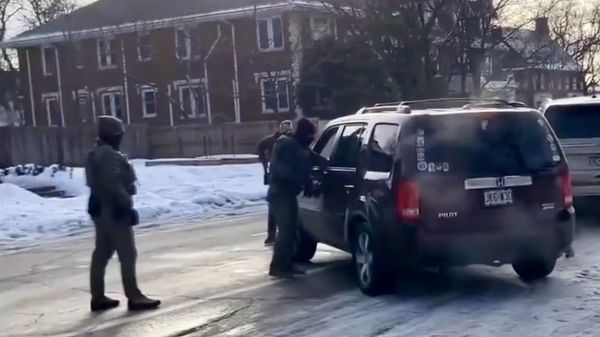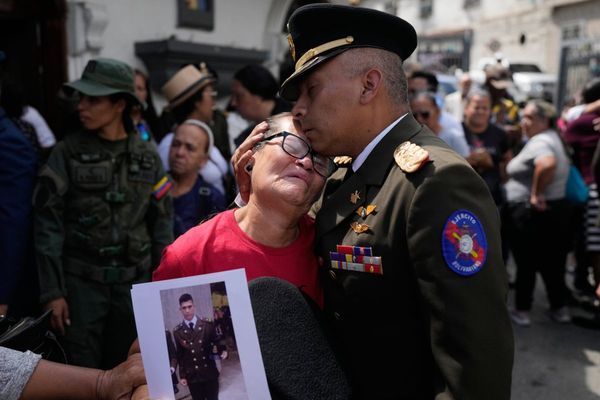Nageswar Kumar and Kailash Kumar are farmers and friends. Today, there is one more thing that binds them together: the grief of losing a child.
On June 2, an accident involving three trains took place in Balasore district of Odisha. Their sons — 18-year-old Ghanshyam and 22-year-old Hardev — had boarded the 12841 Howrah-Chennai Coromandel Express, one of the three trains. Nageswar and Kailash had rushed to Balasore, located 400 kilometres from their home in Dumka district in Jharkhand. “I visited hospitals in Balasore, Soro, and Cuttack,” said Nageswar. “I lifted the white sheets off 107 bodies. But there was no sign of him.”
Two days later, they made a final attempt to search for their sons, who were travelling to Chennai to work for a construction company. At the site of one of the deadliest train crashes of India in two decades, near the Bahanaga Bazar railway station, they walked past large cranes lifting damaged coaches from the railway tracks. Rescue personnel and anguished family members milled around the site. The two fathers were finally turned away by Railway Protection Force personnel. They stood under the sun, eyes brimming with tears, unsure of what to do next.
Nageswar finally traced the body of Ghanshyam to the All India Institute of Medical Sciences (AIIMS) Bhubaneswar. Kailash has still not found Hardev.
Also read | Ringing mobile phones help relatives find injured kin
Rajesh Kumar, senior divisional commercial manager, South Eastern Railway, explained how the accident took place. On the evening of June 2, the Coromandel Express left the main line and allegedly entered the loop line about 500 metres from the Bahanaga Bazar station. There, the train, which was travelling at a speed of 128 kilometres per hour, crashed into a stationary goods train loaded with iron ore. The tremendous impact of the collision caused the coaches of the Coromandel Express to derail. Some of the coaches were thrown across the adjacent tracks, where two general coaches of the incoming 12864 Bengaluru-Howrah Superfast Express rammed into them, said Kumar, who was part of the rescue operations. The accident has claimed 288 lives and left 1,200 passengers injured.
Hearing the deafening sounds from these crashes, the residents of at least five villages and towns nearby ran to the spot. They said they initially saw dust clouds in the night sky. Minutes later, it became clear that a terrible accident had taken place. They heard cries of help from the coaches piled on top of one another and saw mangled bodies and blood everywhere.
Champati Behera, a resident of one of the villages, said he was horrified by the scene. “I ventured into that wreckage. While I was trying to lift a woman who was lying in a pool of blood inside an overturned coach, another person grabbed my leg. I can never forget that sight,” he said.
In search of livelihood
For migrant labourers from remote pockets in West Bengal, Jharkhand, Bihar and Odisha, the Coromandel Express is a much sought-after train. In their desperation to earn a decent living, many people from these regions board the general coaches of the Coromandel Express, even if it means being packed like sardines in a tin for 17 hours. They find work in Chennai or travel to Andhra Pradesh, Telangana, Kerala and other parts of Tamil Nadu in search of decent wages. Sometimes, employers provide loyal and skilled workers sleeper class tickets.
“I have only three bighas of upland agricultural fields,” said Nageswar, who hails from Dumarjore village in Jharkhand. “The crop output is not even enough to feed my family for a full year, forget earning anything from it. A daily wage worker cannot fetch more than ₹200 per day, and finding regular jobs is difficult.”
Also read | IRCTC walks the extra mile to facilitate insurance settlements
The children in his village, he said, start working from the age of 16. By the time they are 20, they identify workplaces in south India and begin work as daily wagers in the construction, apparel and plywood sectors. The passengers who sustained injuries and the ones who died were largely between the ages of 20 and 40 years. It is rural India that has borne the brunt of this accident: most of the dead were migrant labourers and have left behind families who are both grief-stricken and worried about their survival.
The catastrophic evening
Deepak Kumar Behera, a 35-year-old retired Army jawan, described the accident site as a “war zone.” He recalled hundreds of villagers gathering at the spot within minutes of the crash. “Everyone called auto-rickshaws and started sending injured passengers to hospital. Auto-rickshaw drivers did not pay attention to their fuel stock,” he said. As locals like him ventured deeper into the wreckage, they found several coaches lying twisted, mangled, and even upside down.
B. Anu, a 35-year-old woman who works in a prawn farm, has been admitted in the Balasore District Headquarter Hospital with multiple fractures. She shivered while recalling the details of the accicent and her rescue. Anu was travelling in a general coach of the Superfast Express. “I was returning to Chandipur in Balasore district from Srikakulam district of Andhra Pradesh. When I gained consciousness after the accident, I found myself lying under the weight of five bodies. I could only move my hand. A person who was travelling with me pulled me out from the heap of bodies,” she said.
While the first responders were locals, personnel of the Odisha Disaster Rapid Action Force (ODRAF) and the National Disaster Response Force (NDRF) hurried to the spot with fire and gas cutters soon after the accident.
Dhanjaya Kumar, a district commandant of the NDRF, recollected the magnitude of the crisis: “A man in his thirties had been embracing a body for six hours before he was rescued. In a general coach of the Coromandel Express, we found a man sandwiched between the wall of the toilet and the bodies around him. He was shrieking. He had not been able to move for hours.”
In Odisha, the third battalion of the NDRF is extensively trained in dealing with disasters such as cyclones and floods. But the horrific train accident of June 2 taught the unit many lessons, said NDRF personnel.
“Hundreds of people could be saved because of timely action. Odisha has gained experience from responding to disasters. Infrastructure including gas cutters, hydraulic lifters, diesel generators, lighting equipment and fast-moving ambulances were quickly deployed,” said Hemant Sharma, State Industry Secretary, who was supervising work at the crash site.
Within hours of the accident, Union Minister of Railways Ashwini Vaishnaw reached the site and began monitoring rescue operations as well as track repair work. He had served a three-year tenure in Balasore as Collector in 1999 during which time a cyclone ravaged the district. Two days after the train accident, Vaishnaw stood by the track and watched as train services resumed.
The ‘wall of the dead’
While the track is functional, the Indian Railways has two immediate problems at hand. The first is to find out how the accident occurred.
On June 5, there was a flurry of activity in the station master’s room at the Bahanaga Bazar station. An intermittent beeping sound emanated from the block panel, which serves as a controlling mechanism for setting signals and aligning tracks for trains. Protocols on how to avoid accidents, and what should be done in the event of signals and points failing, were pasted on the wall. “The train signal is connected via underground optic fibre to the track. And the routes are set remotely from the station manager’s office,” a senior railway official explained.
The station master and a staff member constantly monitored the block panel as senior officials from the Railways, including the Director General of Safety, and the Central Bureau of Investigation (CBI) visited the accident spot to investigate the possibilities of sabotage or malfunction of technology.
The Coromandel Express was not scheduled to stop at the station. On that ill-fated evening, the station master and a pointsman were on duty, said a senior Railways official, who was present at the accident site. Nearly 50 officials including the station master and the pointsman have now been placed under inquiry and have been told not to resume their jobs until the probe is complete.
The second problem is the quick handover of bodies. As per protocol, bodies that remain unclaimed after 72 hours are reported ‘missing’ and the state decides what to do with them.
A thick book, neatly bounded in green, lay at the office. It contained over 200 photographs of mutilated bodies, each bearing a unique number. The Balasore district magistrate, Dattatraya Shinde, said that the office had decided to process the death certificates of nearly a hundred bodies that had been handed over to families. Shinde was concerned about the bodies that remained unidentified. But he ruled out mass cremation as an option.
On June 6, all the bodies were shifted to AIIMS in Bhubaneswar, but distraught family members continued to throng Balasore’s Fakir Mohan Medical College and Hospital. They scanned the ‘wall of the dead’ in the hospital, which contained over a hundred blown up photographs.
Jagdishchandra Prasad from Howrah was frantically searching for his brother on the wall. He broke down when he saw the picture labelled body number 100. “I am not fully sure if this is him, but it could be,” he kept saying to the Odisha health department staff at the help desk. The staff member asked Prasad to go and search for the body in Bhubaneswar, three hours away.
For some families, this is not possible. The parents of Hansraj and Raghuveer, from Dumarjore village of Jharkhand’s Dumka, said they had to accept that they would no longer see their sons. “If we continue to search for their bodies, costs will go up and we simply cannot afford it,” they said.
Doctors at AIIMS; the Bhubaneshwar municipal corporation; State and police officials from West Bengal, Andhra Pradesh, Jharkhand, Bihar and Odisha; and Government Railway Police staff have been working round the clock to ensure that bodies are handed over to the rightful claimants.
Late at night on June 6, Seemati Murmu, a tribal woman from Jharkhand, parked herself outside the AIIMS committee room. She clutched her bank account details and her husband Chander Todu’s Aadhaar card. She claimed that body number 64 was her husband. But the Odisha Police insisted that a blood relative be called to submit their DNA sample, so that it could be matched with the preserved tissue sample taken from the corpse. A day later, Chander’s brother Hari came to the hospital from Jharkhand to give his blood sample. Hari is one of the 49 blood relatives who have given their blood samples so far.
Up to 89 bodies lay unidentified until the evening of June 7 amid “extreme pressure” from senior officials to hand them over, said a senior Railways official. “While at first, we were handing over the bodies to the people who claimed them, we became careful after two days,” the official said. Compensation of up to ₹15 lakh had been announced for the victims’ next of kin.
A senior UIDAI official said that in one case, a body’s biometrics had been taken. The body was handed over to the claimant along with the compensation cheque as it was impossible to verify the biometrics and match them with those of the claimant within a short period of time. “But after two days, when the results came in, the identity of the body was found to be different. Immediately, a stop cheque instruction was issued and an investigation was requested,” the official said.
“That multiple families are staking claim to the same bodies has complicated the situation,” said AIIMS director Dr. Ashutosh Biswas. Since the CBI is conducting an inquiry, all the samples have been flown to AIIMS Delhi. “We should receive DNA sample results in 7-10 days,” he said.
Murmu and dozens of families have been assured that the results of the DNA matching tests will be conveyed to them over a phone call. They have been advised to return to their villages after submitting their samples.
Recurring nightmares
While relatives search for their loved ones, the injured are struggling to deal with trauma.
At the Fakir Mohan Hospital, Jitendra Nayak, an injured passenger, was getting ready to be discharged. Four months ago, Nayak, 29, had taken a loan of ₹30,000 at a hefty interest of 26% to pay his father’s medical bills. “But my father died of cardiac problems,” he said. Nayak, a resident of Dhapakand village in Basta block of Odisha, then decided to travel to Chennai. “I was promised a job that would fetch me ₹18,000 a month. That is twice the amount we can get in the village through small-time farming,” he said.
Nayak first travelled from his village to Balasore station by bus at a cost of ₹40. He then bought a general reservation ticket worth ₹350 and boarded the Coromandel Express. He remembered eating a piece of bread and drinking some water before the accident took place.
Editorial | Tragic track: on the Balasore train accident and corrective measures by the Indian Railways
Since the crash, Nayak has been unable to sleep properly. “Every three-four hours, I wake up with a jolt after a nightmare,” he said. The tragedy has forced him to make a vow, which is never to travel by train again.







